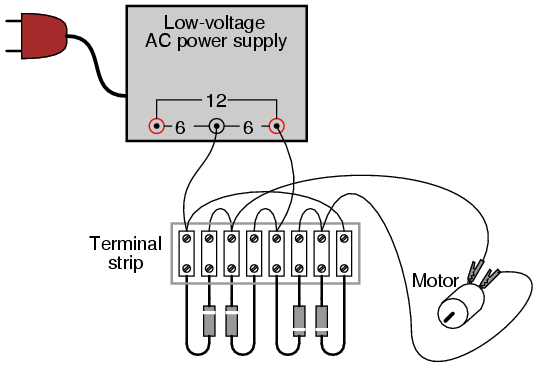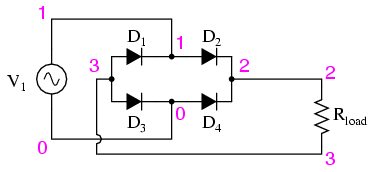Full-wave bridge rectifier
PARTS AND MATERIALS
- Low-voltage AC power supply (6 volt output)
- Four 1N4001 rectifying diodes (Radio Shack catalog # 276-1101)
- Small "hobby" motor, permanent-magnet type (Radio Shack catalog # 273-223 or equivalent)
CROSS-REFERENCES
Lessons In Electric Circuits, Volume 3, chapter 3: "Diodes and Rectifiers"
LEARNING OBJECTIVES
- Design of a bridge rectifier circuit
- Advantages and disadvantages of the bridge rectifier circuit, compared to the center-tap circuit
SCHEMATIC DIAGRAM

ILLUSTRATION

INSTRUCTIONS
This circuit provides full-wave rectification without the necessity of a center-tapped transformer. In applications where a center-tapped, or split-phase, source is unavailable, this is the only practical method of full-wave rectification.
In addition to requiring more diodes than the center-tap circuit, the full-wave bridge suffers a slight performance disadvantage as well: the additional voltage drop caused by current having to go through two diodes in each half-cycle rather than through only one. With a low-voltage source such as the one you're using (6 volts RMS), this disadvantage is easily measured. Compare the DC voltage reading across the motor terminals with the reading obtained from the last experiment, given the same AC power supply and the same motor.
COMPUTER SIMULATION
Schematic with SPICE node numbers:

Netlist (make a text file containing the following text, verbatim):
Fullwave bridge rectifier v1 1 0 sin(0 8.485 60 0 0) rload 2 3 10k d1 3 1 mod1 d2 1 2 mod1 d3 3 0 mod1 d4 0 2 mod1 .model mod1 d .tran .5m 25m .plot tran v(1,0) v(2,3) .end
